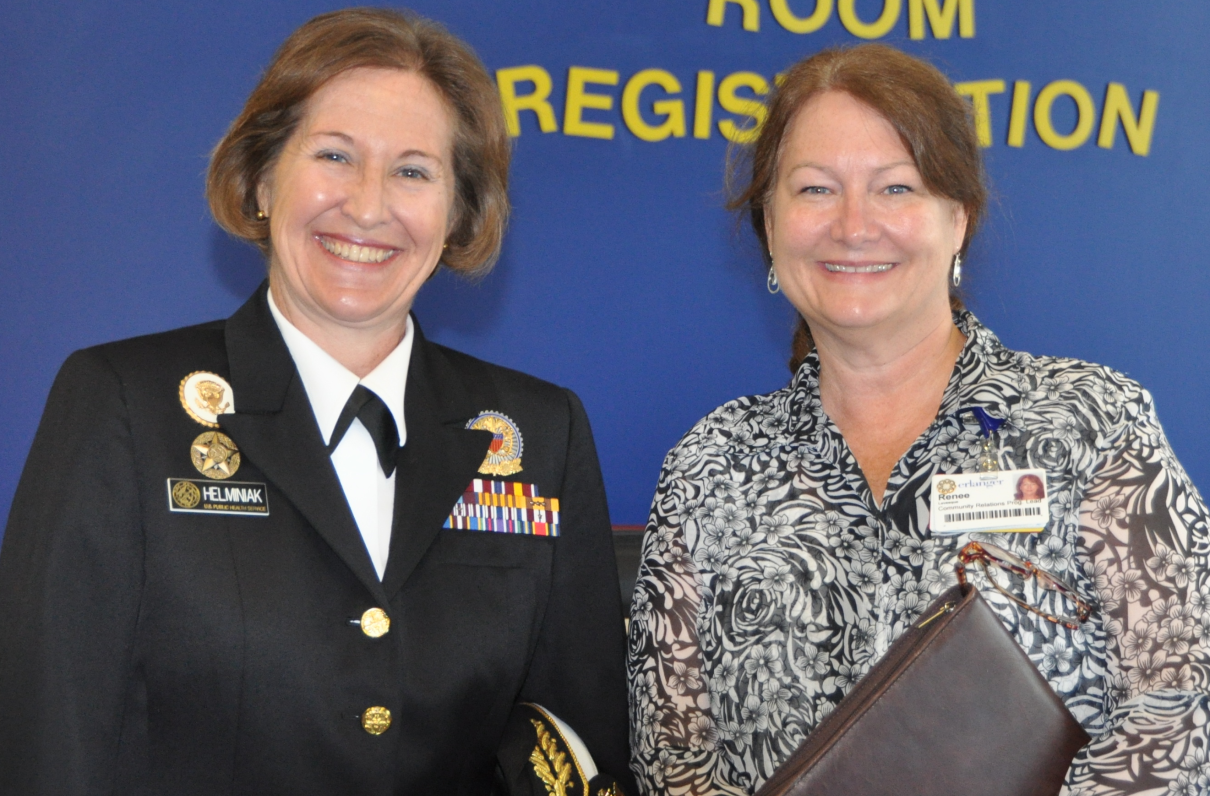(This content originally appeared in the June 2020 issue of Military Officer, a magazine available to all MOAA Premium and Life members. Learn more about the magazine here; learn more about joining MOAA here.)
Rear Adm. Clare Helminiak served as the chief medical officer of the U.S. Public Health Service from 2009 to 2013. Not long after she took command, she was charged with coordinating a task force for the influenza A H1N1 virus — which was rapidly spreading in the U.S.
Now retired and serving on MOAA’s board of directors, Helminiak watched closely as the Commissioned Corps responded to battle COVID-19 and applied lessons learned from H1N1.
“Health care workers are used to the demands placed on them,” Helminiak said. “But health care workers in America work hard every day, and we’re just seeing now that they’re really stepping up to the plate when the demands are incredible. You know, kind of like the warfighter. This is just fighting a war against a disease.”
[RELATED: On the Front Lines: USPHS Officers and the COVID-19 Pandemic]
Helminiak’s 30-year career included work as primary care physician and health care administrator at isolated duty stations for the Indian Health Service in Alaska, Arizona, Montana, and New Mexico. Serving both domestically and on-site in Afghanistan, she worked for five years on Afghan health care reconstruction.
It was a demanding career that concluded with her role as chief medical officer in Washington, D.C., where she was responsible for ensuring officers were ready to deploy to support medical missions and respond to disasters around the world.
During the H1N1 response, once a vaccine was created, Helminiak’s task force fine-tuned a logistics plan to safely distribute and administer it. The basis of that plan is used today.
“In H1N1, there was a new vaccine, and we had to send it out, make it in large quantities, and make sure it got sent out everywhere safely to the people that needed it,” Helminiak said. “And that’s going to be really important when we’ve got the coronavirus vaccine to try to work with state, local, tribal, and territorial governments to distribute the vaccine and make sure they can administer it to their whole population.”
[RELATED: USPHS Ready Reserve Corps Becomes Law With the CARES Act]
Q. Whether it’s H1N1 or COVID-19, why is it important to have a task force dedicated to fighting the disease?
A. In the early 2000s, when I was at the White House, we developed the national response framework. And that’s a very important document because that just describes how the nation will respond: all the federal departments, the agencies, state and local governments in the civilian flow respond to disasters and emergencies.
So, in the national response framework, they defined these emergency support function annexes that say, “Who has this lane?” It’s critical to bring a group together that talks consistently and has the same message to send out … so everybody understands what’s going on and what’s going to happen next.
[LATEST NEWS AND UPDATES: MOAA.org/Coronavirus]
Q. When you worked at the Office of the Assistant Secretary for Preparedness and Response as a deputy director in the Office of Preparedness and Emergency Operations, one of your responsibilities was to help get federal medical resources to communities that were maxed out. During the coronavirus response, we saw tents go up in parks in New York. What does that say about the U.S. response?
A. This is exactly what we planned for ... putting up tents in parking lots and the medical surge. And that’s exactly what the government’s been planning for, for 20 years.
We have a civilian system called the National Disaster Medical System. Those are civilians who are pre-trained and rostered into teams, whether they’re medical, mortuary, or veterinary. That’s a huge federal asset that can be sent out, whether it’s the tsunami in Indonesia or a major hurricane. They can be used to augment where needed.
[RELATED: MOAA Interview: Head of USPHS Commissioned Corps on 2020 and Beyond]
Q. Sometimes the Commissioned Corps is overlooked because it’s small, but at this moment, it is in the spotlight. What does it mean to you to see that the Corps is taking on this mission to fight COVID-19?
A. Every few years, somebody tries to say, “We need to just get rid of the Commissioned Corps of the Public Health Service because we don’t need uniformed people doing this, and we want to save money.” And then something happens. And this has been the cycle.
Suddenly something happens, and every department in the government suddenly needs a public health consultant. We provide a very unique service, and we have officers with incredibly broad skill sets who can essentially plug and play anywhere in any department in any federal agency, in any environment.
And that’s an asset the government really needs because you can’t always ask a civilian to take on those kinds of roles. You need a flexible, multifaceted group of officers who can be detailed in those roles. It’s almost like breathing air. You don’t notice it until it’s gone, and then you discover you really need it.
Stay Informed
It’s more important than ever to make sure you’re in the know and your military benefits are protected.
